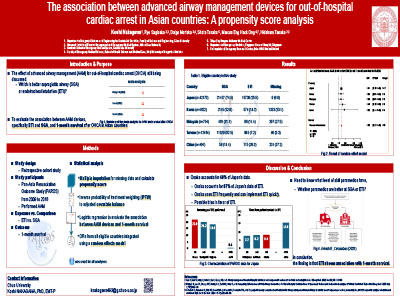ABSTRACTS
The Association Between Advanced Airway Management Devices for Out-of-Hospital Cardiac Arrest in Asian Countries: A Propensity Score AnalysisAuthor: Koshi, Sagisaka Ryo, Morioka Daigo, Tanaka Shota, Ong Marcus, and Tanaka Hideharu | | Associate Authors:
Objective: To evaluate the association between advanced airway management (AAM) devices, specifically endotracheal intubation (ETI) and supraglottic airway device (SGA), and 1-month survival after out-of-hospital cardiac arrest (OHCA) in Asian countries using the Pan-Asia Resuscitation Outcome Study (PAROS) registry. Methods: This cohort study utilized data from participating PAROS countries, including Japan, Korea, Malaysia, Taiwan, and China. Patients with OHCA were categorized into ETI and SGA cohorts, and 1-month survival was the primary outcome. Multiple imputation for missing values and propensity analysis were employed. Adjusted odds ratios (aORs) and 95% confidence intervals (CIs) were estimated for the association between AAM devices and 1-month survival in each country using the inverse probability of treatment weighting (IPTW) method. A random effects model was used to integrate the aORs and 95% CIs, estimating the overall effect size in PAROS. Results: A total of 59,820 patients were included in this study. The IPTW analysis yielded the following aORs and 95% CIs on ETI versus SGA for each country (Figure 1): Japan (aOR = 1.31, 95% CI = 1.18–1.45), Korea (aOR = 1.26, 95% CI = 0.94–1.69), Malaysia (aOR = 1.26, 95% CI = 0.94–1.69), Taiwan (aOR = 1.49, 95% CI = 1.12–1.98), China (aOR = 1.82, 95% CI = 0.44–7.49). The results from the random effects model indicated that AAM was significantly associated with 1-month survival (aOR =1.32, 95% CI = 1.23–1.40]). There was no heterogeneity of results across countries (I2 = 0.0%). Conclusion: This study indicated that ETI was significantly associated with 1-month survival compared to SGA. While most of the data weighting was from Japan, which may limit generalizability to other Asian countries, the consistent direction of results in each country suggests the potential importance of reliable oxygenation provided by ETI.
|

